A FEATURE I wrote for the ‘Darlington and Stockton Times’ in June led to two people reminiscing about the life of Darlington born Doug Hardy who died in China in June 1942. After reading the feature Wendy Acres of Darlington contacted me because she so wanted to meet someone who had known Mr Hardy who was, she explained, her first cousin once removed.
(Above) Wendy Acres with Peter Leyland
“There are very few of my family left now and I was very small when Doug left England,” she said. So she was delighted to have an opportunity to visit Peter Leyland at his home in Bainbridge in Wensleydale.
Mr Leyland and Mr Hardy became friends at the Quaker College at Ackworth, shared a berth on the voyage to India and to Burma, and worked together with the Friends’ Ambulance Unit (FAU) in China.
She was also very pleased that Mr Leyland said he would ask if the certificate Mr Hardy had been awarded could be deposited later in the archives of the Society of Friends (Quakers). (above: Ms Acres and Mr Leyland with the certificate)
Mr Leyland said that the Executive Yuan of the Chinese Republic during the war had only issued the illuminated certificates to the two members of the FAU who had died while serving there. Both John Briggs from Horsforth near Leeds and Mr Hardy died from typhus.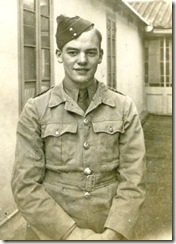
Mr Hardy had joined the FAU because he was a conscientious objector like the rest of his family. He and his parents had attended a Methodist church in Darlington. (right) Doug Hardy
During her visit on Monday afternoon Ms Acres showed Mr Leyland photographs of Mr Hardy and the letters which had been sent by a doctor and a nurse who had nursed him at the mission hospital until his death. The nurse had written that even when very distressed “his manner was always just beautiful”.
“I’ve enjoyed reminiscing this afternoon even if about a sad time. I was very cut up when Doug died,” said Mr Leyland.
……..
I have been working with Mr Leyland, who is known to many by his given name of John, on an oral history record of his interesting life. From that I produced the feature that caught Ms Acres attention. Here it is:
THE earthquake in China has brought back memories for Peter Leyland of Bainbridge in Wensleydale of transporting medical aid to Sichuan Province during the Second World War.
(Right) Peter and Janet Leyland studying his China diary and photographs.
One month remains particularly unforgettable and that was June 1942. First he lost a very close friend and then he heard that his father, John, had died. As he was a volunteer with the Friends Ambulance Unit in China, and the Japanese had cut off the road link to Burma, there was no way he could get to his father’s funeral in Bainbridge. (See In Remembrance)
Peter was articled as an accountant in London when the Second World War broke out. He served with the FAU in London during the Blitz and then joined the “China Convoy” as it became known. After lessons in Chinese, mechanics and first aid he and about 40 others headed for Burma late in 1941. Ten months later, on June 10, when in West China, he wrote in his diary that the unit was at its lowest ebb in morale – and that was before he heard of the death of his friend, Douglas Hardy. Doug, from Darlington, had attended the Society of Friends school at Ackworth with Peter.
They had shared a cabin in the City of Baroda when it sailed from Glasgow in September 1941 during the height of the U-boat war in the Atlantic. During the journey they had gone sight seeing together in South Africa and India and in China had met each other regularly.
On Saturday, June 13 ,1942 he wrote: “Doug died on Thursday. It seems he developed typhus and with the dysentery just hadn’t the resistance. Poor Doug – I suppose he is the last of us I should have wished to go, having known him since school and being such great friends during our time together in this convoy. He has been buried at Anshun. I am gathering Doug’s things together.” For the China Convoy this was the second death from typhus for John Briggs had died on June 9. John was from Horsforth near Leeds and his parents built almshouses there in his memory.
While Peter was mainly confined to an office as the unit’s accountant John and Doug were convoy drivers and mechanics. Doug and Peter had been at sea between Calcutta and Rangoon when news of the Japanese attack of Pearl Harbour broke. Most of the coolies left Rangoon after the Japanese bombed the city and Peter and other FAU team members themselves loaded valuable hospital equipment straight from the docks onto their trucks ready for the drive over the Burma Road to China. Some of the FAU team were almost trapped in Rangoon when the Japanese invaded but managed to get out with their valuable lorries and cargoes. (Photo: A convoy on its way to Kunming.)
Peter helped with the drive north to Lashio and on into China. On January 2, 1942, the scenery was so awe inspiring that he almost forgot it was his 22nd birthday. The day before they had driven up Maymyo Hill, a rise of 3,000 feet in six miles in a series of 22 hairpin bends.
(For photos of the China convoy and others of FAU in China click here )
He wrote in his diary: “Rather like a long stretch of Kidstones Pass, Wharfedale side, at the top. The view from the top across the plain with the Irrawaddy meandering in the distance was striking.” (The Kidstones Pass is in the Yorkshire Dales National Park.)
The following day they headed towards the Goktech Gorge. “We came over a hill and saw this steep narrow gorge down below , with mist hanging in its depths. In the distance we could see the railway viaduct, which crosses 1,000 ft above the river. We drove down into the gorge, having to reverse on some of the bends in order to get round them. My hand brake behaved very badly. Crossing the bridge at the bottom we climbed very steeply by means of another series of hairpins. This time I had to reverse on just one, but having to back towards the edge is not pleasant. I believe that some chaps had to reverse on three or four of these bends.” He said later “That was the first time I experienced hairpin bends on mountainous roads. The Salween gorge was even more awesome!”
It was not long before the Burma Road was closed by the Japanese and the FAU made its headquarters near Kunming in China. There was a desperate shortage of petrol and so most of their lorries were converted to run on charcoal. Doug had been one of the pioneers of using such adapted lorries.
(Left) Checking a charcoal burner on a truck.
Peter explained:“Our job was mainly to transport these medical supplies with our charcoal burners throughout west China to the various hospitals. The Government of China was established in Chongqing and we were transporting these medical supplies brought in over the Hump throughout this west China region mainly Yunnan, Guizhou and farther north Sichuan. Chongqing was in the middle of Sichuan on the Yangtze.” The Hump was the name given to the air supply route over the Himalayas from India to Kunming over the Himalayas.
As an accountant his main problem was the level of inflation which was often at 20 per cent per month. Foreign currency for the China Convoy was sent to the British Embassy in Chungking and was only converted into Chinese dollars as and when needed. When drawing Chinese dollars from the bank Peter had to take a rucksack because he received the money in huge wads of notes. “We when we paid wages to our Chinese staff they would immediately rush round to the market. They converted it as soon as they could into goods, rice and food – it was really quite extraordinary,” he said.
In November 1945 as he came to the end of his time with the FAU he was asked to travel home via North America to talk to some of the donors about inflation accounting. But then he got a telegram informing him that his only brother, Derrik, had died.
He headed home to support his mother but was held up in India for three months waiting for a berth on a ship. Within days of his reaching Bainbridge she introduced him to her fiancé, Anthony Pim, who was a master at Bootham School in York where Derrik had also been teaching. So he went back to London to complete his accountancy training. He went on to become the finance director of the Scott Bader Commonwealth.
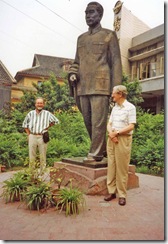 It wasn’t until 1992 that he and a fellow China Convoy man, Theo Willis, who grew up in Carperby in Wensleydale, went back to China with their wives. The tourist group they were with was taken to see the house in Chongqing where Chou En-lai, had lived during the war. Chou En-lai was later the Chinese premier. “When inside Theo looked to the right and said – ‘that’s where Duncan Wood and I sat with Mao Tse-tung and Chou En-lai who had organised a meeting to thank the FAU for the help we had given by getting medical supplies to them in Yenan. All of our group was quite overcome with surprise at this – a bit of living history and several afterwards said it was the best bit of their whole trip.”
It wasn’t until 1992 that he and a fellow China Convoy man, Theo Willis, who grew up in Carperby in Wensleydale, went back to China with their wives. The tourist group they were with was taken to see the house in Chongqing where Chou En-lai, had lived during the war. Chou En-lai was later the Chinese premier. “When inside Theo looked to the right and said – ‘that’s where Duncan Wood and I sat with Mao Tse-tung and Chou En-lai who had organised a meeting to thank the FAU for the help we had given by getting medical supplies to them in Yenan. All of our group was quite overcome with surprise at this – a bit of living history and several afterwards said it was the best bit of their whole trip.”
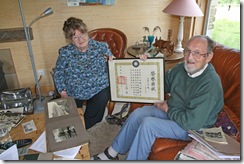
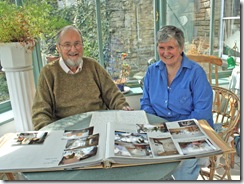
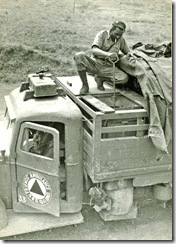
Dear Sir,
I graduated from a medical school in Chengdu, China (formerly West China Union University, founded by 5 missionary societies, including Quakers) and also a PhD graduate from U of Toronto, Canada. I am now working as a scientist in a hospital in Fargo, ND USA.
I am writing a non-commercial research article about the history of my medical school in China and especially for the architectures that designed by a Quaker architect. Possibly, this article may be published in Chinese in China.
For introducing Quakers helps in China I need to use one historic photo about FAU in China from your web site. ((Right) A convoy in China)
I would appreciate it very much if you could allow me to do so in my writings with your kind copy right permission.
Thanks you very much.
Robert Luo
Janet Rawlins Leyland did give permission.
Interesting reading – my late stepfather David Morris was also one of the China Convoy; I’ve created this website about his book.
I believe that the Convoy photo was taken by Stanley T Betterton, it’s on my website courtesy of his daughter.l, who owns the copyright.
I’d be very interested if you have other similar photographs; I love the one of the charcoal burner!
Best wishes